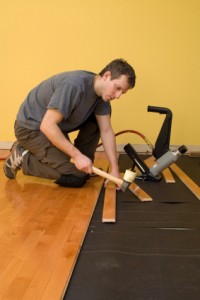Engineered Hardwood Flooring – The Basics

Engineered hardwood flooring is more popular these days than natural hardwood flooring. This is because the construction of engineered hardwood flooring gives it qualities that natural hardwood flooring does not have. This allows engineered hardwood flooring to be less expensive and more resistant to moisture.
There are several differences in the construction of natural hardwood flooring and engineered hardwood flooring. Natural hardwood flooring is constructed entirely out of a piece of hardwood. The only hardwood used for engineered hardwood flooring is for the top layer. The possible types of hardwood that are used for engineered hardwood include oak, pine, ash, teak, and bamboo. The top layer allows engineered hardwood flooring to have the same visual beauty as natural hardwood flooring. There is a core layer that is glued to the bottom of the top layer. The core layer consists of layers of replenishable and affordable wood. These layers of wood might be medium-density or high-density fiberboard or plywood. The number of layers that are used for the core vary from one flooring manufacturer to another. Most flooring manufacturers will use three layers of wood in the core. However, there are several flooring manufacturers that are beginning to construct core layers that consist of five to seven layers of wood. They are adding more layers of wood to the core because the extra layers will make their engineered hardwood flooring more durable.
During extreme changes in the weather, natural hardwood flooring can expand and contract so much that it will buckle or warp. The core layer of an engineered hardwood floor gives it the ability to expand and contract without buckling or warping as natural hardwood flooring would. This means that engineered hardwood flooring is less affected by environmental conditions and can be installed in more areas than natural hardwood flooring. For example, unlike a natural hardwood floor, you can install an engineered hardwood floor in a humid or damp basement. An engineered hardwood floor can also be installed over radiant heating system without suffering any damage. If you install a natural hardwood floor over a radiant heating system, the natural hardwood floor could buckle, cup, or shrink.
Engineered hardwood flooring can be installed as a floating floor. This means that you can install an engineered hardwood floor on a surface without using glue or nails. A floating floor will allow you to have a floor that is free of gaps between the hardwood panels. But before you install the engineered hardwood floor, you have to place a vapor barrier between the surface and the floor. A tongue and groove locking system allows the engineered hardwood flooring to be installed as a floating floor. With this system, you can just click and lock the engineered hardwood planks together. This means that the engineered hardwood flooring can be installed very quickly. Also, if you are moving, you can easily take the hardwood planks apart and take it to your new home. This locking system also makes it pretty easy to replace any planks that are damaged.
The finish of engineered hardwood flooring is durable. An engineered hardwood floor will still look good even after years of heavy use. However, if it is necessary, engineered hardwood flooring can be refinished. But this is not a task that you should take on yourself. This is something that you should pay a professional to do. But each engineered hardwood floor can only be refinished a limited number of times before you destroy the top layer.
Michael Russell
Your Independent guide to Flooring
Article Source: http://EzineArticles.com/?expert=Michael_Russell
*Article opinion is that of the writer, not Floorhardwoods. Articles are provided as a convenience to our customers and we hope you enjoy them!